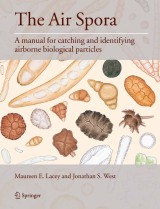Details

The Air Spora
A manual for catching and identifying airborne biological particles|
CHF 260.00 |
|
| Verlag: | Springer |
| Format: | |
| Veröffentl.: | 03.02.2007 |
| ISBN/EAN: | 9780387302539 |
| Sprache: | englisch |
| Anzahl Seiten: | 156 |
Dieses eBook enthält ein Wasserzeichen.
Beschreibungen
<P>The Air Spora is an illustrated guide to trapping, identifying and quantifying airborne biological particles such as fungus and plant spores and pollen. This book will be of use to anyone interested in aerobiology or studying applied aspects such as dispersal and effect of allergens, or human, animal and plant pathogens. Including a comprehensive review of what is in the air and detailing the historical development of theories leading to modern aerobiology, the book explains the fundamental processes behind airborne dispersal and techniques used to sample, identify and quantify biological particles. Methods are explained in a step-by-step guide for the use of standard air sampling devices. Although formats applicable to modern molecular and immunological techniques are described, the emphasis of the book is on simple visual identification of particles in air samples using traditional microscopy. Consequently a chapter on setting-up and using a light microscope is included, although experienced researchers can skip to chapters showing photographs of examples of the Air Spora and nine colour plates of paintings of airborne particles at a magnification of x1000.</P>
<P> </P>
<P>"I recommend this book to those actively running or thinking of running a pollen and spore trapping program. It will also be of value to doctors, allergists, and those teaching the basics of palynology, wishing to include a lecture or two on air spora." </P>
<P></P>
<P>David M. Jarzen, Florida Museum of Natural History</P>
<P>In: The Newsletter of the American Association Of Stratigraphic Palynologists, 2007(40:2)</P>
<P> </P>
<P>"I recommend this book to those actively running or thinking of running a pollen and spore trapping program. It will also be of value to doctors, allergists, and those teaching the basics of palynology, wishing to include a lecture or two on air spora." </P>
<P></P>
<P>David M. Jarzen, Florida Museum of Natural History</P>
<P>In: The Newsletter of the American Association Of Stratigraphic Palynologists, 2007(40:2)</P>
Chapter 1 Introduction to Aerobiology 1. What is aerobiology 2. The Air Spora 3. What is in the air 4. Early history of aerobiology 5. Aerobiology as a discipline 6. Aerobiology in action Chapter 2 The Aerobiology Pathway 1. Introduction 2. Take-off (Release) 3. Dispersal 4. Deposition - sedimentation and impaction 5. Impact 6. Interpreting spore trap data 7. Dispersal by rain splash and aerosol Chapter 3 Air Sampling Techniques 1. Introduction 2. Passive traps 3. Cascade impactor 4. Andersen sampler 5. Whirling arm trap 6. Burkard trap 7. Cyclone and minature cyclone samplers 8. Virtual impactors and liquid impingers 9. Filters Chapter 4 Using a Burkard Trap 1. Introduction 2. Siting the trap 3. Running the trap Chapter 5 Using a microscope 1. Introduction 2. Microscope structures 3. Using a microscope 4. Measuring and calibration Chapter 6 Pollen and spore counts 1. Introduction 2. Counting pollens and spores from a Burkard trap 3. Counting pollen and spores from a whirling arm trap Chapter 7 Identification 1. Introduction 2. Particle types 3. Useful references 4. Paintings –x1000 Appendix Glossary References Index Chapter 1 Introduction to Aerobiology 1. What is aerobiology 2. The Air Spora 3. What is in the air 4. Early history of aerobiology 5. Aerobiology as a discipline 6. Aerobiology in action Chapter 2 The Aerobiology Pathway 1. Introduction 2. Take-off (Release) 3. Dispersal 4. Deposition - sedimentation and impaction 5. Impact 6. Interpreting spore trap data 7. Dispersal by rain splash and aerosol Chapter 3 Air Sampling Techniques 1. Introduction 2. Passive traps 3. Cascade impactor 4. Andersen sampler 5. Whirling arm trap 6. Burkard trap 7. Cyclone and minaturecyclone samplers 8. Virtual impactors and liquid impingers 9. Filters Chapter 4 Using a Burkard Trap 1. Introduction 2. Siting the trap 3. Running the trap Chapter 5 Using a microscope 1. Introduction 2. Microscope structures 3. Using a microscope 4. Measuring and calibration Chapter 6 Pollen and spore counts 1. Introduction 2. Counting pollens and spores from a Burkard trap 3. Counting pollen and spores from a whirling arm trap Chapter 7 Identification 1. Introduction 2. Particle types 3. Useful references 4. Paint
Comprehensive review of the history, equipment and techniques used in aerobiology Over 340 colour paintings of airborne particles to unified scale for help in identification Illustrated laboratory guide for trapping and counting of airborne particles No other book of its type Accessible to and understandable by non-specialists Comprehensive guide to aerobiology Includes supplementary material: sn.pub/extras
Diese Produkte könnten Sie auch interessieren:

Handbook of Poisonous and Injurious Plants

von: Lewis S. Nelson, L.R. Goldfrank, Andrew Weil, Richard D. Shih, Michael J. Balick

CHF 142.00















